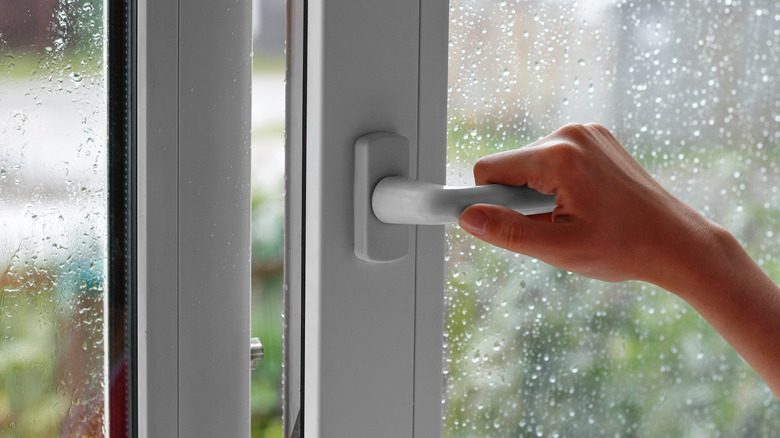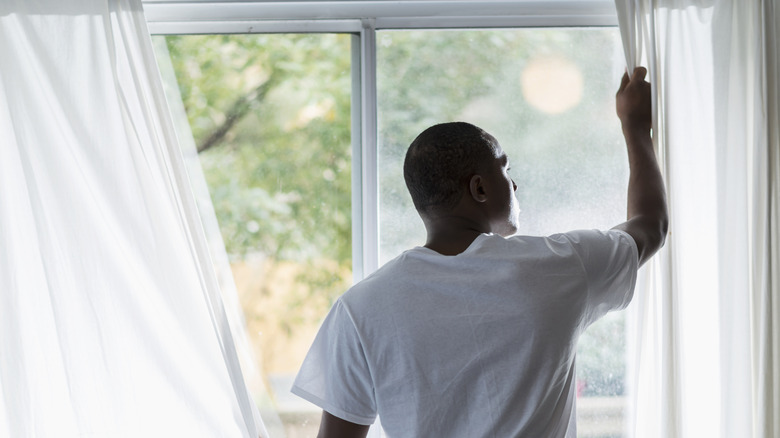Why Some People Swear By Opening Their Windows When It Rains (& Should You?)
Homeowners turn to a variety of air purification methods to avoid having stuffy rooms filled with old, stagnant air. One of the most common ways to fix a stuffy room is to open a window. Many people specifically do this to let fresh air in when it rains. This is a good idea only in the right conditions, according to Micah Sherman, a Virtual HVAC Expert for the home repair and maintenance app Frontdoor. "Opening windows during a rainstorm can be beneficial, particularly in spring and summer, for cooling and fresh air," Sherman explained while speaking exclusively to House Digest.
Before you consider opening your windows during a rainstorm, take a moment to assess your local environment. "In very humid climates, opening the windows during a rainstorm will only allow more humidity to enter the home, leading to discomfort," the expert shared. You will want to avoid excess humidity that could potentially lead to mold. Opening windows during the cooler seasons, including fall and winter, may also make your home way too cold. Although letting air blow into your home during a rainstorm might be refreshing, keep in mind that it can cause damage if done carelessly.
Consider air quality and humidity levels before opening windows
Along with humidity levels, you should also take outdoor air quality into consideration before you open your windows to cool down your home on a rainy day. This is especially important if you are trying to let fresh air inside in hopes of improving your indoor air quality. "If the air quality is poor, then leaving the windows open can negatively impact your health," Sherman explained while speaking exclusively to House Digest. "This is especially important to consider during 'allergy season' when pollen is at its peak."
The expert also shared that your HVAC system can effectively complete its job of removing pollen and other pollutants from the air when the windows are closed. This is another reason to keep outside air out of your home if the air quality in your area is poor. Although it is important to follow these precautions, you do not have to keep your windows shut at all times throughout the year. You can crack a window on those low humidity days if you do not have to worry about pollen or other pollutants in your outdoor environment. You may want to stay on top of your local air quality to determine when it is and is not appropriate to let fresh air inside.
Other tips for maintaining fresh indoor air
Now that you know when it is appropriate to open your windows to let air in, you should be able to use this method to help freshen up the air in your home safely. Sherman recommends popping them open for no more than 15 to 30 minutes. This is enough time for fresh air to replace air that has been impacted by cooking fumes, chemicals, or a humid shower. If you choose to do this during a rainy day, monitor the open windows to ensure water is not making its way inside your home, as you probably want to avoid spending money renovating your windows due to water damage.
For those who are curious about how humidity and temperature try to find stasis in the air, Sherman also provided an explanation of the process. "In simple terms, air tries to balance temperature and humidity by constantly moving and mixing heat and moisture through natural processes," he shared while speaking exclusively to House Digest. "For example, after a hot shower, the bathroom fills with hot and humid air. If you open the bathroom door, the humid air will begin to diffuse into the rest of the house, which will have drier air. Simultaneously, the heat from the warm, moist air will transfer to the cooler, dry air in the house, while cooler air might flow into the bathroom."


